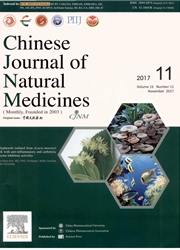

 中文摘要:
中文摘要:
Traditionally, determination of inhibitory potency of complement inhibitors is performed by the hemolytic assay. However, this assay is not applicable to the lectin pathway, thus impeding the understanding of complement inhibitors against the overall function of the complement system. The main objective of our study was to develop a specific enzyme-linked immunosorbent assay(ELISA) as an alternative method to assess the anti-complement activity, particularly against the lectin pathway. By using respective coating substrates against different activation pathways, followed by capturing the stable C3c fragments, our ELISA method can be used to screen complement inhibitors against the classical pathway and the lectin pathway. The inhibitory effect of suramin on the classical pathway, as measured by our hemolytic assay is consistent with previous reports. Further assessment of suramin and Bupleurum polysaccharides against the lectin pathway showed a good reproducibility of the method. Comparison of the lectin pathway IC50 between Bupleurum smithii var. parvifolium polysaccharides(1.055 mg/mL) and Bupleurum chinense polysaccharides(0.98 mg/mL) showed that, similar to the classical and alterative pathway, these two Bupleurum polysaccharides had comparable anti-complementary properties against the lectin pathway. The results demonstrate that the described ELISA assay can compensate for the shortcomings of the hemolytic assay in lectin pathway.
 英文摘要:
英文摘要:
Traditionally, determination of inhibitory potency of complement inhibitors is performed by the hemolytic assay. However, this assay is not applicable to the lectin pathway, thus impeding the understanding of complement inhibitors against the overall function of the complement system. The main objective of our study was to develop a specific enzyme-linked immunosoihent assay (ELISA) as an alternative method to assess the anti-complement activity, particularly against the lectin pathway. By using respective coating substrates against different activation pathways, followed by capturing the stable C3c fragments, our ELBA method can be used to screen complement inhibitors against the classical pathway and the lectin pathway. The inhibitory effect of sununin on the classical pathway, as measured by our hemolytic assay is consistent with previous reports. Further assessment of suramin and Bupleurum polysaccharides against the lectin pathway showed a good reproducibility of the method. Comparison of the lectin pathway IC5is between Ruplearum.smithii var, purviPliam polysaccharides (1.055 ingtmE) and Buplcurann chinense polysaccharides (0.98 ing/mL) showed that similar to the classical and alterative pathway, these two Bupleurum polysaccharides had comparable anti complementary properties against the lectin pathway. The results demonstrate that the described EIASA assay can compensate for he shortcomings of the hemolytic assay in lectin pathway. (C) 2015 Chinese Pharmaceutical Association and Institute of Materia Medica, Chinese Academy of Medical Sciences. Production and hosting by Elsevier B.V. This is an open access article under the CC BY-NC-ND license (http://creativecommons.org/licenses/by-nc-nd/4.0/).
 同期刊论文项目
同期刊论文项目
 同项目期刊论文
同项目期刊论文
 Bupleurum Polysaccharides Attenuates Lipopolysaccharide-induced Inflammation via Modulating Toll-Lik
Bupleurum Polysaccharides Attenuates Lipopolysaccharide-induced Inflammation via Modulating Toll-Lik Macrophage immunomodulatory activity of the polysaccharides from the roots of Bupleurum smithii var.
Macrophage immunomodulatory activity of the polysaccharides from the roots of Bupleurum smithii var. A New Unusual Delta(11(12))-Oleane Triterpene and Anti-complementary Triterpenes from Prunella vulga
A New Unusual Delta(11(12))-Oleane Triterpene and Anti-complementary Triterpenes from Prunella vulga Anti-complementary Constituents of Houttuynia cordata and their Targets in Complement Activation Cas
Anti-complementary Constituents of Houttuynia cordata and their Targets in Complement Activation Cas Simultaneous determination of six steroidal saponins and one ecdysone in Asparagus filicinus using h
Simultaneous determination of six steroidal saponins and one ecdysone in Asparagus filicinus using h Viola yedoensis Liposoluble Fraction Ameliorates Lipopolysaccharide-Induced Acute Lung Injury in Mic
Viola yedoensis Liposoluble Fraction Ameliorates Lipopolysaccharide-Induced Acute Lung Injury in Mic Isolation of an anti-complementary polysaccharide from the root of Bupleurum chinense and identifica
Isolation of an anti-complementary polysaccharide from the root of Bupleurum chinense and identifica 期刊信息
期刊信息
